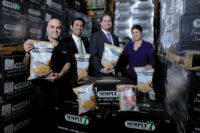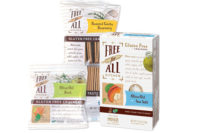Simple crunch time
Simple 7 Snacks works diligently to provide healthier , tasty extruded snacks














Launching its own snack brand only three years ago, Simply 7 Snacks has copacked snacks for customers across the country for years. Its 45,000-sq.-ft. production facility in Houston outputs about 100,000 bags a day of preservative-free lentil, hummus and pomegranate chips in a variety of flavors, shapes and sizes. Gearing up to expand, it’s currently developing more ‘better-for-you’ snacksand looking to gain ground in nonsnack product categories.
Wanting to provide consumers with better-for-you, flavorful, gluten-free snacks, Simply 7 Snacks, LLC, Houston, knows that people are starting to eat better and smarter, so the snack copacker began offering a bounty of the light, preservative-free, puffed, extruded snacks in 2011. The tasty chips are made of beans, rice and seeds instead of more conventional things like potatoes and corn.
The newfangled snacks proved highly successful, and the company tripled its sales last year and intends to do the same in 2013. “We have grown exponentially since we launched our own brand, and added production capacity and personnel to support our rapid growth,” says Rashim Oberoi, president. “We’re going beyond traditional products with things like hummus, lentil and pomegranate chips—foods that are simpler, based on ingredients that are becoming popular in other areas of the grocery store.”
The snacks come in 12 different flavors and in bag sizes from 1 to 15 oz. Currently, the company produces as many as 40 stock-keeping units. Distributed nationally to major grocery retailers, natural supermarkets and food stores and specialty markets, Simply 7 chips come in flavors such as savory Cheddar, Sea Salt, Creamy Dill, Brushetta, Jalapeno, Spicy Chili Pepper and Tomato Basil. There’s even a sweet treat: New Dark Chocolate Pomegranate chips, which are sold seasonally.
Not as simple as it sounds
Copacking other companies’ products for years, Simply 7 Snacks waited to launch its own brand, Oberoi points out. “It took us a while to develop our own products,” he says.
That’s because the recipes aren’t as simple as they seem. “It’s tricky to create all of our extruded snacks,” he says. “A lot more people would be doing it if it was easy. Making everything out of simple, easy-to-pronounce ingredients can simplify a [materials budget], but it can also cause challenges. For example, a lot of snacks use preservatives to make things easier. We adapt our recipes to provide a more natural product. We also have a six-month shelf life, and we can’t use preservatives, so we must make sure our packaging supports that shelf life, and that our recipes will work within that structure.”
The use of low-sodium, low-fat, preservative-free, gluten-free ingredients can also complicate research and development when it comes to creating new recipes, acknowledges Paul Albrecht, vice president. “It extends the research and development process. We’ll often get a concept product that may contain complex ingredients. We might have to scrap it or come up with a different version because if it has complicated ingredients, it could destroy our brand concept. Other companies may say it tastes great and go to market, but if it tastes good but has something we don’t accept, we won’t market it. Producing on a just-on-time basis helps, but we have to make adjustments, which can complicate the operation.”
During Snack Food & Wholesale Bakery’s visit, Hummus Chips with Sea Salt were being made and packaged. The facility’s 50 employees demonstrated that they are ready to tackle just about anything. Allergen ingredients are stored separately from nonallergen ingredients and to keep things straight on the production lines, the staff working with them wears blue uniforms; those working with nonallergens wear red.
Snack production for the week starts at 6 a.m. on Monday and stops at 6 a.m. on Saturday. “The two lines output all of the snacks,” points out Oberoi. “We change over quite a bit from flavor to flavor, product to product and from our brand to products we copack.”
On a weekly basis, there can be five to 10 changeovers a day, Oberoi says. Both lines run all products, both copacked and the company’s own brand. “With all of the growth we’ve experienced, this year, we’re going to install a third production line,” he adds.
Mixing, extruding, cutting
Simply 7 Snacks built the scrupulously clean facility on a parcel of land that can accommodate future expansion. Running 24 hours a day, five days a week, with weekly cleanings, the plant incorporates two processing lines, one custom-designed, single-screw extruder and two packaging lines (so far). The lines are programmable-logic-controlled (PLC), with touchscreens positioned on the cookers for easy access. “We are always looking at new ways to automate our lines,” mentions Oberoi.
A recently installed, 75,000-lb. silo outside of the facility holds bulk cooking oil that's pumped into the extrusion room. Dry ingredients (mostly in bulk sacks) are warehoused in a five-rack-high portion of the building as well as at offsite warehouses. Operators dump the bulk ingredients into the extruder hopper and the product mixes in a continuous process in the single-screw extruder.
During our visit, the mixture was extruded into shell shapes that were cut into individual pieces and dried. “We found that the single-screw system works best for this product, because lentils are rather difficult for a twin-screw system to work with much-moisture-wise,” Oberoi says. “It doesn’t matter with a single-screw system how fine a product is.”
The hopper feeds the raw ingredients on the top while a die at the bottom creates the product’s shape. Individual pieces eject from the extruder into a large bag and sit overnight before they’re dispensed from the bags into the cookers (for more specifics about extrusion technology for snacks, see our Future Food column on p. 40).
Cooking seasoning, drying
After the shells dry, which takes about 24 hours, operators dump them into small bins that they use to pour the shells into a hopper above one of two cooking systems on each of the lines. The cooker tumbles the shells and controls how quickly they move through the system, regulating speed. The shells are then cooked in hot oil and puff up, becoming crispy and light. Temperatures and cooking times vary, depending on the product, but the temperatures range from 160-300 deg. C; cooking times range from 5-15 seconds. “Remember, a lot of the cooking happens in the extruder,” explains Oberoi.
As the chips near the end of the processing line, they pass a chute that can reject items that aren’t cooked properly. “We have recipes and moisture and fat levels and other criteria that are checked on all of the products,” he adds. “We typically reject the first 10 minutes of every production run so that everything that’s packaged is consistent and of high quality.”
Depending on its condition, the rejected product can be reused as farm feed after it's ground. It can also be put back into the system if it’s reusable. The chips dry further as they move through a set of troughs and convey on a wide belt into a tumbling seasoner drum that flavors them with a powdered seasoning blend. The wide belt removes a lot of the oil, which keeps the fat levels down. After the chips are cooked, they flatten slightly because there is an aerator in the system. The seasoned chips next drop from the seasoner into an elevating conveyor that leads them overhead and out of the room, into the packaging area.
On to packaging
Upon entering the packaging room, the chips move overhead onto a vibratory conveyor that feeds them into one of two 16-bucket weighers connected to one of two vertical form/fill/seal baggers below. “We have three people that operate each line and usually six on the packaging lines,” Oberoi explains.
The maintenance department comes in during any changeovers to inspect the equipment and also do a major cleaning and inspection after the lines shut down on Saturdays. “We also shut down one week a year for maintenance as well,” Oberoi says.
On the day of our visit, one line bagged chips in a 15-oz. clubstore size while the other generated a private-label brand in single-serve, 1-oz. bags. A metal detector on each line checks the chips after they’re deposited into the bags before the filled bags are sealed and accumulate on a rotating table to be case-packed by hand. The cases are taped closed by a semi-automatic taper and then a pressure-sensitive label is applied to each case by a print-and-apply system. The cases are then loaded onto pallets by the line operators.
“We want to put in a case erector and a feeder on the lines,” Oberoi observes. “We are just about to change up some of the packaging machines so that we can install a bag orienter that uprights the bags to streamline production.”
After palletizing, the loads are forklifted to an adjacent five-rack-high warehouse to be automatically stretch-wrapped and stacked on the racks. A Quality Assurance lab located to the side of the packaging room tests the chips and the packaging on an hourly basis. The battery of tests includes a check for bag integrity, titration, bag-seal quality, batch numbers, moisture, weights and nitrogen pressure in the case of the exported bags, a double-check on metal detection and more.
According to Oberoi, extruding snacks is a relatively economical process. “It’s energy-efficient, doesn’t generate much waste and is easy to control, so that desired properties can be ‘dialed in,’” he says. “The same equipment can be used for a lot of different products and changeovers are quick.”
When the economy got bad, Simply 7 Snacks wasn’t as affected as other food companies. “People still have to eat,” Oberoi notes. “Perhaps they didn’t travel or eat out as much, but they went back to the basics and still wanted a snack. The snack category actually grew. At the end of the day, people are still going to spend a little on a treat.”
An added bonus: While most commodity prices affected food manufacturers, Simply 7 Snacks didn’t feel as much of a pinch. “We didn’t suffer as much as other food companies because we don’t use traditional commodity ingredients,” Oberoi says. Everyone at Simply 7 Snacks also wears many hats and can jump into a new project in a moment’s notice. “That requires a certain type of person,” he points out. “There’s no set path, so everyone helps out where they can, and that’s what I’m most proud of.”
Proving his point, his conversation trails off as he moves over to one of the packaging lines to help the staff case-pack the bags of chips. “We treat everyone here like family,” he sums up, smiling. “There’s no corporate ‘guy in the sky’ who directs things. I think that’s one reason why we’re successful.”
Looking for a reprint of this article?
From high-res PDFs to custom plaques, order your copy today!















